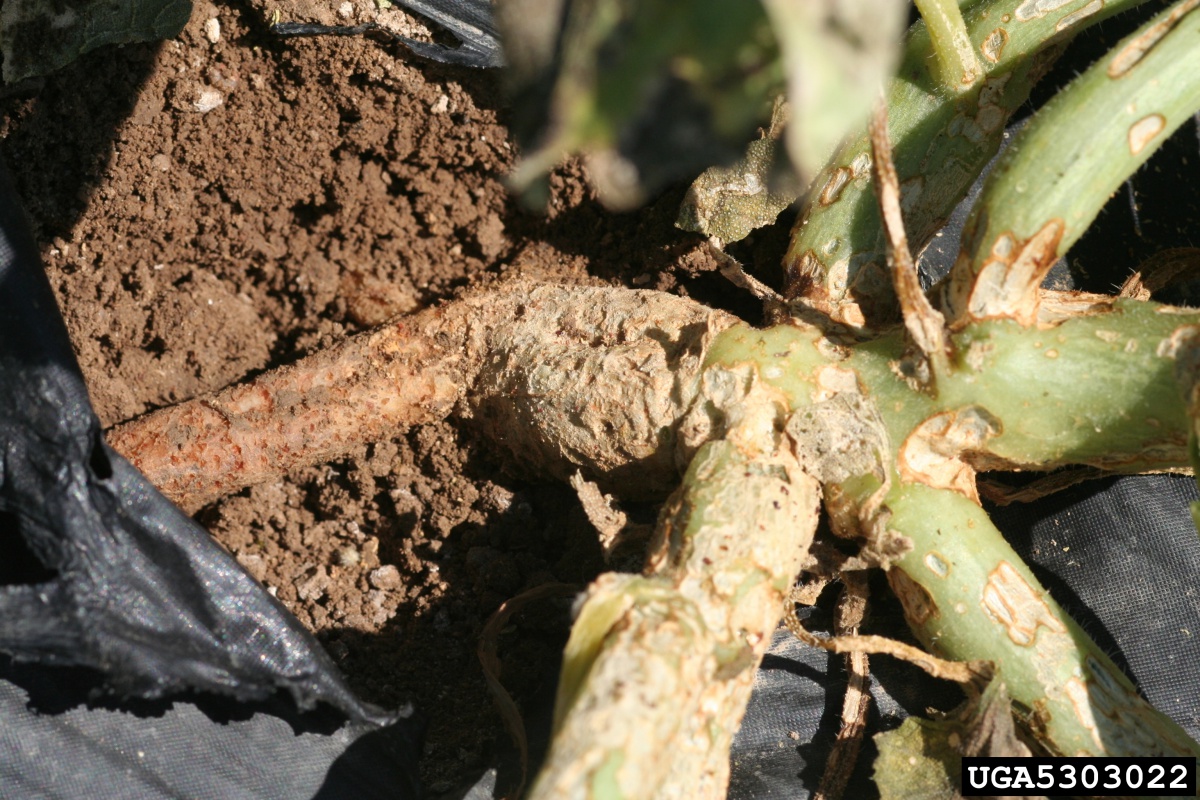The striped cucumber beetle, Acalymma vittatum, is one of the most devastating pests of cucurbits (cucumbers, summer and winter squashes, all types of melons and pumpkins) east of the Rocky Mountains. Both adults and larvae feed on cucurbit crops. This insect is also responsible for the spread of plant diseases such as bacterial wilt and squash mosaic virus. Cantaloupes and muskmelons are especially vulnerable to bacterial wilt spread by the beetles.
Description
The adult beetles are 1/4" long and yellow-green with black longitudinal stripes. Eggs are small and orange-to-yellow in color. The worm-like larvae are slender, white, and about 1/3" long when full-grown.

Cranshaw, Colorado State University, Bugwood.org.
Life Cycle
The insects overwinter as unmated adults in the neighboring areas of old cucurbit patches, under fallen leaves, in hedgerows, near their wild food sources (goldenrods and asters), or in garden debris. Adults emerge in early spring before cucurbits are available as food, and feed on pollen, petals, and leaves of alternative hosts.
Once cucurbits begin to emerge or once protective cover is removed, the adults migrate to their preferred hosts and begin chewing on leaves and stems. The beetles mate at this time and females deposit their eggs at the base of host plants, below the ground surface. Upon hatching (8-10 days) the larvae migrate to the root system and feed upon roots for 2-6 weeks, during which time they may consume the entire root system. Larvae pupate in the soil, emerging as adults in about one week. In fall, the adults return to the outlying areas for winter. Depending on geographic region and weather conditions, New Hampshire gardens may experience one to three generations of striped cucumber beetle in any given season.

and adult scarring). Credit: Whitney Cranshaw, Colorado State University,
Bugwood.org.
Management
IPM Strategies:
- Cultural practices - Rotate cucurbit crops to a new place in the garden or farm each year. Cover planting beds with floating row covers immediately after planting seeds or setting out plants. Remove row covers as plants begin to bloom, to ensure adequate bee pollination. Applying a heavy mulch of straw, leaves, or grass clippings around established plants may help reduce striped cucumber beetle attacks.
- Sanitation - At the end of the season, destroy or bury crop debris (vines, leaves, remaining fruits) to deprive adults of overwintering spots. Consider destroying asters, goldenrod or other nearby pollen (food) sources for the adults.
- Monitoring - Early in the growing season, check plants frequently for adult beetles or chewing damage on cucurbit stems and foliage. Adult beetles are difficult to handpick, as they fly away or drop to the soil to hide when plants are disturbed. The presence of adult beetles or visible damage to plants may indicate a need for chemical control. The most susceptible time is from crop emergence or transplanting until the plant has reached the 5-leaved stage.
- Chemical Control - Hundreds of products are registered to control striped cucumber beetles. Check the labels of any product you purchase to ensure that both the target insect (striped cucumber beetle) and the plants you intend to spray are listed. Follow all label instructions. If the crop is in bloom when treatment is required, select an insecticide that is low risk to pollinators and spray at dusk. Avoid spraying insecticide in the morning on squash-family crops in bloom.
Guidelines for control of the striped cucumber beetle are in the New England Vegetable Management Guide. For a more personalized recommendation, consult your county Agricultural Field Specialist.

Cranshaw, Colorado State University, Bugwood.org.

Stop! Read the label on every pesticide container each time before using the material. Pesticides must be applied only as directed on the label to be in compliance with the law. All pesticides listed in this publication are contingent upon continued registration. Contact the Division of Pesticide Control at (603) 271-3550 to check registration status. Dispose of empty containers safely, according to New Hampshire regulations.
Download the resource for the complete factsheet.

